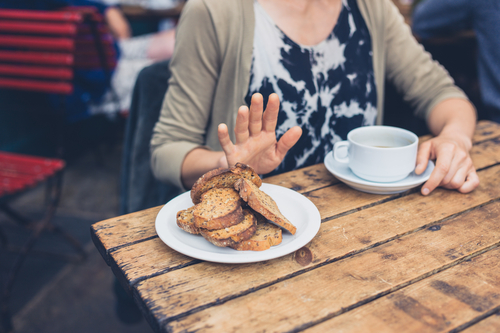
Approximately 1 in 100 people worldwide are affected by celiac disease. While this disease manifests itself through painful and uncomfortable symptoms a mindful diet can help curb symptoms and inflammation as soon as possible. Before we examine some great diet options, let's learn more about celiac disease, what it does to the body, and how it affects people.
What is Celiac Disease?
It's an adverse reaction from your immune system after consuming food that contains gluten, a protein in certain grains. The gluten in the grains, (namely wheat, rye, and barley), irritates and inflames the intestines.
Celiac Disease Symptoms
What are some of the most common celiac disease symptoms?
- Fatigue
- Constipation
- Diarrhea
- Pain of the abdomen
- Bloating
If you regularly experience these symptoms, you should see your health care provider for an evaluation. While these symptoms may be from celiac disease, there are other disorders that should be considered.
Celiac disease shares many of the same symptoms as other gastrointestinal issues like inflammatory bowel disease (IBD), Crohn's disease, and colitis. It is also important to note that not everyone who feels bad after consuming gluten has celiac disease. Some people have a gluten sensitivity, which is not immune mediated. Therefore, it is best to have a full evaluation before making the diagnosis of celiac.
The Best Celiac Disease Diet Practices to Live Comfortably
Now we'll be looking at some of the best practices to engage in to ensure you'll have the least amount of complications. Those familiar with IBS diets will recognize many of the food products and ingredients.
Everyone's eating habits, and bodies are different, so be sure to consult with your doctor about specific dietary practices, foods, and products before undertaking drastic diet changes.
Gluten-Free Diet
First and foremost, the key to making celiac diets work effectively is to cut out gluten entirely. It may seem obvious, but you need to avoid everything like wheat, barley, and rye. Be vigilant when you read the labels.
Since gluten is the leading cause of celiac disease symptoms, cutting it out entirely is the goal. "A gluten-free diet is critical," explains Mildred Bentler, Summit Health nutritionist. "Making the switch to gluten-free allows those with celiac disease to live more comfortably.”
Bentler recommends The Gluten Free Scanner and the Find Me Gluten Free phone apps, finding them both to be helpful resources for patients.
A Quick Note on Gluten-Free Diet Efficacy
While modified diets can make a world of difference for patients, it's still possible to experience various celiac disease symptoms even after eliminating gluten from your diet.
Foods for Celiac Disease Sufferers to Avoid
The first step in getting celiac disease under control is to eliminate gluten from your diet. You should avoid the following foods which commonly contain gluten.
- Couscous
- White bread
- Beer
- Bagels
- Flour tortillas
- Malt
- Soy sauce
- Doughnuts
- Noodles
- Pretzels
- Pasta
A comprehensive list of foods containing gluten can be found at celiac.com and celiac.org.
Why does a fruit and vegetable diet always show up on various diet recommendations? Fruits and vegetables contain essential vitamins and minerals and having a balanced diet of them gives people a healthy mixture of fiber, vitamins, and potassium. Both fruits and vegetables are also low in calories and sodium, serving as a preferable alternative to salty snacks like chips and pretzels.
Having large amounts of fiber can be much easier on the intestines, making it easier to live comfortably with celiac disease.
A Diet of Grains for Celiac Disease Sufferers
Getting enough grains in your diet is a great way to stay healthy while attempting to minimize celiac disease symptoms from food. With plenty of nutrients, grains are a must for any diet.
Some great grains to include in your diet are:
- Gluten-free oats
- Gluten-free granola
- Corn
- Quinoa
- Rice cakes
- White or brown rice
- Pasta from rice, or legumes such as chickpeas or lentils
- Millet
With a gluten-free diet, it's essential to examine the food to see if the product is made with gluten. If you're a lover of classic breakfast food like waffles and cereal, there are plenty of gluten-free alternatives made with enriched flour to satisfy your hunger as well as keep you healthy.
Another thing to keep in mind is that many foods are processed alongside gluten products and may undergo cross-contamination before rollout.
A Diet of Unprocessed Food for Celiac Disease Sufferers
While meat is generally considered gluten free, processed meat may contain additives that contain gluten. Processed meat contains carcinogens, which are incredibly unhealthy.
Some processed meats and foods to avoid:
- Lunch meat
- Fried foods such as French fries, fried chicken or fish, mozzarella sticks, etc.
- Soups with noodles
Those with celiac disease can safely eat unprocessed meat, like plain chicken, as it's naturally gluten-free. As with fruit, brown rice, beans, and oats, they pose little to no health risks.
Final Thoughts on Celiac Disease Diet Tips
Hopefully, working out a process to eliminate foods like wheat, barley, rye, and other products filled with gluten works for you. A key to living a healthy life is recognizing problem areas and doing your best to eliminate them.
Once again, it's essential to consult with your doctor or dietitian to see which diet and food plan to follow.
At Summit Health, our gastroenterology department is here to help determine the cause of your stomach discomfort and find the right treatment plan for you. Additionally, those with celiac disease and other related issues can consult our comprehensive nutrition services to get support and education on a healthful gluten-free diet.
Learn more about nutrition services, nutrition specialists, and book an appointment today.
